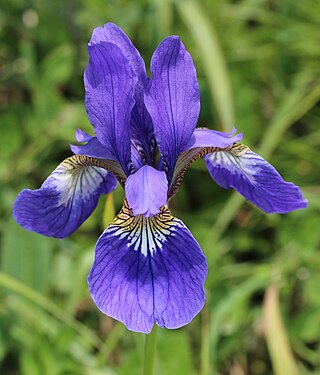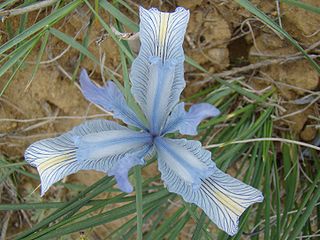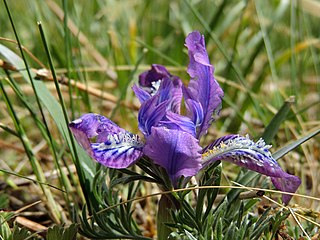
Iris sanguinea is a rhizomatous flowering plant in the genus Iris and in the series Sibiricae. It is cultivated as an ornamental plant in temperate regions. It is one of the species considered a Japanese iris. It is from Asia, found between Russia, Mongolia, China, Japan and Korea. It has grey green leaves, an unbranched flowering stem and flowers in reddish-purple shades, from blue to blue-purple, red-violet, with a rare white variant.

Iris lactea is a species in the genus Iris. It is also in the subgenus Limniris and is the only species in the series Ensatae. The Japanese water iris, Iris ensata, is actually in series Laevigatae. It is a rhizomatous perennial, from central Asia, with pale blue or violet flowers. It is cultivated as an ornamental plant in temperate regions.

Iris ruthenica, sometimes called ever blooming iris, Russian iris, pilgrim iris and Hungarian iris, is a species in the genus Iris- subgenus Limniris. It is a rhizomatous perennial, with a wide distribution, ranging from eastern Europe to Central Asia. It has grass-like leaves, thick stem and violet or bluish lavender flowers which are marked with violet veining.
Iris bungei is a beardless iris in the genus Iris, in the subgenus Limniris and in the series Tenuifoliae of the genus. It is a rhizomatous herbaceous perennial, from Mongolia, Tibet and China. It has green leaves, short stem and 2 violet, purple, lavender or blue flowers.
Iris loczyi is a beardless iris in the genus Iris, in the subgenus Limniris and in the series Tenuifoliae of the genus. It is a rhizomatous herbaceous perennial, from a wide area of Asia, including Afghanistan, Iran, Kazakhstan, Tajikistan, Mongolia, Tibet and China. It has long thin grey green leaves, long stems and 1 flower in pale violet, blue violet, lavender or light blue.

Iris tenuifolia is a beardless iris in the genus Iris, in the subgenus Limniris and in the series Tenuifoliae of the genus. It is a rhizomatous herbaceous perennial, from a wide region over central Asia, including Afghanistan, Pakistan, ; Kazakhstan, Uzbekistan and Mongolia and in China. It has long greyish-green leaves, short stem and pale violet, lilac, pale blue, or purple flowers.
Iris ventricosa is a beardless iris in the genus Iris, in the subgenus Limniris and in the series Tenuifoliae of the genus. It is a rhizomatous herbaceous perennial, from Asia and the Russian Federation, to Mongolia and China. It has grey-green leaves, short flowers stems and 1–2 pale violet or pale blue flowers.
Iris ludwigii, with the common name Ludwig iris, is a species in the genus Iris. It is also in the subgenus Iris subg. Limniris and in the series Spuriae. It is a rhizomatous perennial plant with violet-blue flowers. It is native to the Altai Mountains in Central Asia, where Russia, China, Mongolia, and Kazakhstan meet. It is cultivated as an ornamental plant in temperate regions.
Iris bloudowii is a species in the genus Iris. It is also in the subgenus of Iris and in the Psammiris section. It is a rhizomatous perennial, from Russia, Siberia, Kazakhstan, Mongolia and China, with sickle-shaped leaves, slender stem and 2 bright or pale yellow flowers. It is cultivated as an ornamental plant in temperate regions.
Iris curvifolia is a plant species in the genus Iris, it is also in the subgenus of Iris, and in the Psammiris section. It is a rhizomatous perennial, from China. It has sickle-shaped long leaves, short stem and yellow or bright yellow flowers. It is cultivated as an ornamental plant in temperate regions.

Iris humilis is a plant species in the genus Iris. It is also in the subgenus of Iris and in the Psammiris section. It is a rhizomatous perennial, with a wide distribution range from Europe to Russia to China, via Mongolia and Kazakhstan. It has sword-shaped leaves, a short stem and yellow flowers with an orange beard. It is cultivated as an ornamental plant in temperate regions.
Iris mandshurica is a species in the genus Iris; it is also in the subgenus of Iris and in the Psammiris section. It is a rhizomatous perennial, it is found in Russia, China, and Korea. It has green sword-like leaves, smooth green stem and yellow flowers, with yellow-purple veining and a yellow beard. It is cultivated as an ornamental plant in temperate regions.

Iris vorobievii is a plant species in the genus Iris, it is also in the subgenus of Iris and in the Psammiris section. It is a rhizomatous perennial, from Russia close to the Chinese border. It has long and thin green leaves, similar sized stem and pale yellow or bright yellow flowers with a pale yellow beard. It is cultivated as an ornamental plant in temperate regions.
Iris cuniculiformis is a plant species in the genus Iris, it is also in the subgenus Iris and in the section Pseudoregelia. It is a rhizomatous perennial, from China, it has long and thin green leaves, and 1 lilac large flowers, that have yellow or grey beards. It is cultivated as an ornamental plant in temperate regions.
Iris dolichosiphon is a plant species in the genus Iris, it is also in the subgenus Iris and in the section Pseudoregelia. It is a rhizomatous perennial, from China and Bhutan. It has long, thin dark green leaves, very short stem, and dark blue, purple, or violet flowers. That are mottled with white. It has thick white/orange beards. It has one subspecies, Iris dolichosiphon subsp. orientalis, from China, India and Burma. It has similar flowers. They are cultivated as ornamental plants in temperate regions
Iris ivanovae is a plant species in the genus Iris and part of the subgenus Iris and in the section Pseudoregelia. It is a rhizomatous perennial, from eastern Russia, China, and Mongolia.
Iris psammocola is a plant species in the genus Iris, it is also in the subgenus Iris and in the section Pseudoregelia. It is a rhizomatous perennial, from China. It has grass-like leaves, short stems, yellow flowers. It is cultivated as an ornamental plant in temperate regions.

Iris tigridia is a plant species in the genus Iris; it is also in the subgenus Iris and in the section Pseudoregelia. It is a rhizomatous perennial, from Kazakhstan, Russia, Mongolia and China. It has dark green or greyish green, grass-like leaves, a short slender stem and a single flowers that are either violet, dark blue, blue-purple, dark purple, mauve, lilac, lavender, or light purple. It is cultivated as an ornamental plant in temperate regions.

Iris glaucescens is a plant species in the genus Iris and subgenus Iris. It is a rhizomatous perennial, found in Russia, Kazakhstan, Mongolia and China. It has blue-grey sickle-shaped leaves, slender stem, and spring flowers in blue-violet, pale violet, lilac-purple, to deep purple, to light bluish, and almost white shades. It is rarely cultivated as an ornamental plant in temperate regions. It was merged with another similar iris in the region, and became a synonym of Iris scariosa, before being divided into two separate species again, although some sources still call it a synonym of Iris scariosa.

Iris scariosa is a plant species in the genus Iris; it is also in the subgenus Iris. It is a rhizomatous perennial from the mountainsides of Russia, Kazakhstan, Mongolia and China. It has sword-like, or sickle shaped, blue green or grey-green leaves, a short flowering stem, 3 or 4 membranous or semi-transparent flower bud leaves, 2 violet, reddish violet, lilac, blue-purple, or blue flowers in late spring, with yellow or white beards. It is cultivated as an ornamental plant in temperate regions. It was merged with another similar iris in the region, and Iris glaucescens became a synonym of Iris scariosa, before being divided into two separate species again. Although some sources still call it the main species, despite a slight colour difference.









